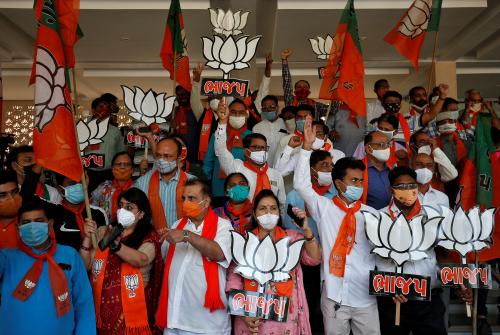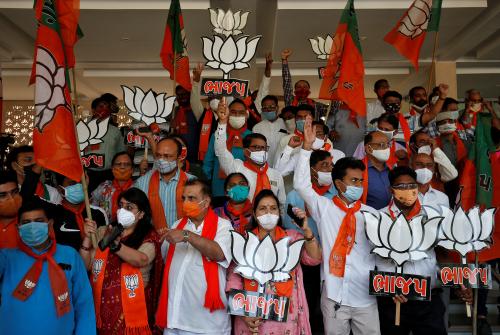Content from the Brookings Institution India Center is now archived. After seven years of an impactful partnership, as of September 11, 2020, Brookings India is now the Centre for Social and Economic Progress, an independent public policy institution based in India.
Disclaimer: All opinion pieces reflect the views of individual scholars. Brookings India takes no positions or institutional view.
On December 11, the results of five Indian state elections – in Rajasthan, Madhya Pradesh, Chhattisgarh, Telangana, and Mizoram – were announced. These will be the last state elections before the 2019 Indian general election, about which speculation will now begin in earnest. Predicting national elections is a notoriously difficult exercise; the last three defied many expectations. Given that media commentators project every state election as a trendsetter for national politics, a simple exercise to start thinking about next year’s outcome involves transposing the results of every state election over the past five years onto a national election map. Basically, this means taking the number of seats a party won in the last election in each state, dividing it by the total number of seats in the state legislature, and multiplying that number by the Lok Sabha seats representing that state.
Crunch the numbers in this manner, and it brings up the following results: the BJP drops some 103 seats and its allies another 7, giving the BJP a total of 179 and its National Democratic Alliance (NDA) coalition about 207 seats. (For context, no winning party won more seats than that in five general elections between 1996 and 2009.) The Congress would certainly gain in this calculation – particularly in Gujarat, Rajasthan, Madhya Pradesh – but would make only about 107 seats total. Along with its allies, the Congress-led United Progressive Alliance (UPA) would have 163 seats. This would represent a big increase from 2014, but is still over 40 short of their competitors. Other regional parties, led by the All India Trinamool Congress, All India Anna Dravida Munnetra Kazhagam, Biju Janata Dal, Telugu Desam Party, and Telangana Rashtra Samiti would be among the largest contributors to 172 seats for third parties and independents.
Now, the caveats. These numbers offer a useful starting point, but should definitely not be interpreted as a prediction, for at least four reasons. The first is that Indian voters have historically distinguished between state-level and national-level issues when they voted, and parties will campaign on very different concerns and personalities. A particularly good example of this was the fact that the 2008 Uttar Pradesh elections – won convincingly by the Bahujan Samaj Party (BSP) – was followed shortly thereafter by a strong showing by the Congress in that state in the 2009 general election. A second reason is that enough time has elapsed from several state elections, notably in Bihar, Delhi, Maharashtra, and Uttar Pradesh, to suggest that they could have little bearing on the next general election.
The third reason is that both pre-poll and post-poll alliances will alter calculations, sometimes significantly. How the likes of the BSP, TDP, and others position themselves will make a meaningful difference, as would campaign strategies between allies. Finally, state election results disproportionately favour state parties and smaller political movements, who are more likely to be crowded out in a general election when fewer and larger seats are at stake. Nonetheless, despite these important considerations, a simple transposition of recent state election results on a national electoral map provides a basic starting point for anticipating what is in play in the run up to the 2019 elections.
Disclaimer: All opinion pieces reflect the views of individual scholars. Brookings India takes no positions or institutional view.




Commentary
Op-edIf State Elections were General
December 13, 2016